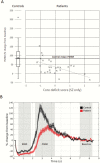Quantifying the Core Deficit in Classical Schizophrenia
- PMID: 32803162
- PMCID: PMC7418866
- DOI: 10.1093/schizbullopen/sgaa031
Quantifying the Core Deficit in Classical Schizophrenia
Abstract
In the classical descriptions of schizophrenia, Kraepelin and Bleuler recognized disorganization and impoverishment of mental activity as fundamental symptoms. Their classical descriptions also included a tendency to persisting disability. The psychopathological processes underlying persisting disability in schizophrenia remain poorly understood. The delineation of a core deficit underlying persisting disability would be of value in predicting outcome and enhancing treatment. We tested the hypothesis that mental disorganization and impoverishment are associated with persisting impairments of cognition and role function, and together reflect a latent core deficit that is discernible in cases diagnosed by modern criteria. We used Confirmatory Factor Analysis to determine whether measures of disorganization, mental impoverishment, impaired cognition, and role functioning in 40 patients with schizophrenia represent a single latent variable. Disorganization scores were computed from the variance shared between disorganization measures from 3 commonly used symptom scales. Mental impoverishment scores were computed similarly. A single factor model exhibited a good fit, supporting the hypothesis that these measures reflect a core deficit. Persisting brain disorders are associated with a reduction in post-movement beta rebound (PMBR), the characteristic increase in electrophysiological beta amplitude that follows a motor response. Patients had significantly reduced PMBR compared with healthy controls. PMBR was negatively correlated with core deficit score. While the symptoms constituting impoverished and disorganized mental activity are dissociable in schizophrenia, nonetheless, the variance that these 2 symptom domains share with impaired cognition and role function, appears to reflect a pathophysiological process that might be described as the core deficit of classical schizophrenia.
Keywords: core deficit; disorganization; mental impoverishment; negative symptoms; post-movement beta rebound; schizophrenia.
© The Author(s) 2020. Published by Oxford University Press on behalf of the University of Maryland's school of medicine, Maryland Psychiatric Research Center.
Figures



References
-
- Kraepelin E. Dementia Praecox and Paraphrenia. Barclay RM, Trans. Edinburgh, UK: ES Livington; 1919.
-
- Bleuler E. Dementia Praecox or the Group of Schizophrenias. Zinken H, Trans. New York, NY: International Universities Press; 1950.
-
- Guloksuz S, van Os J. The slow death of the concept of schizophrenia and the painful birth of the psychosis spectrum. Psychol Med. 2018;48(2):229–244. - PubMed
-
- Insel TR. The NIMH Research Domain Criteria (RDoC) project: precision medicine for psychiatry. Am J Psychiatry. 2014;171(4):395–397. - PubMed
Grants and funding
LinkOut - more resources
Full Text Sources

